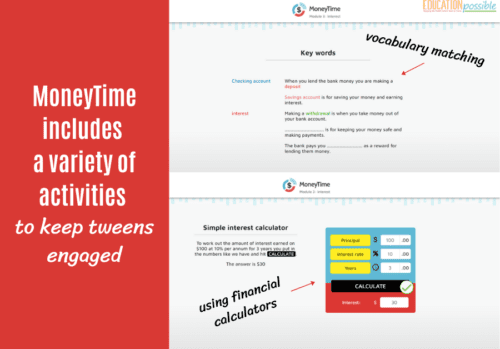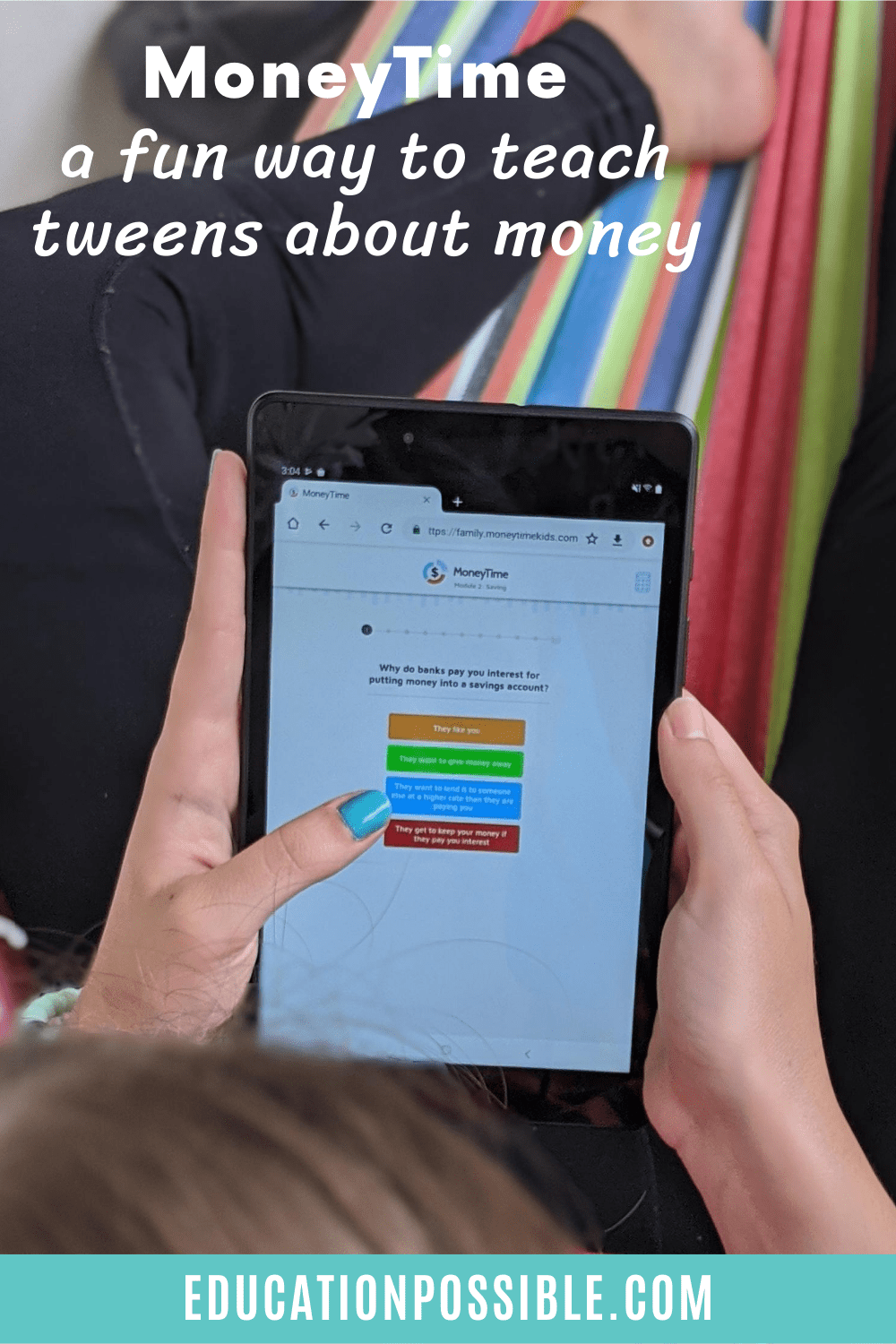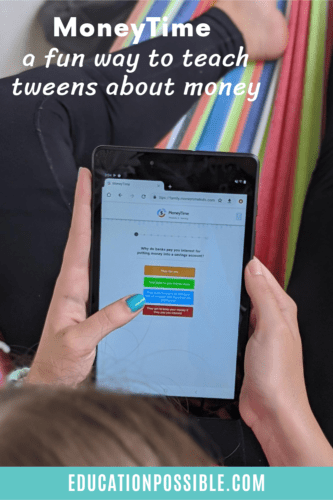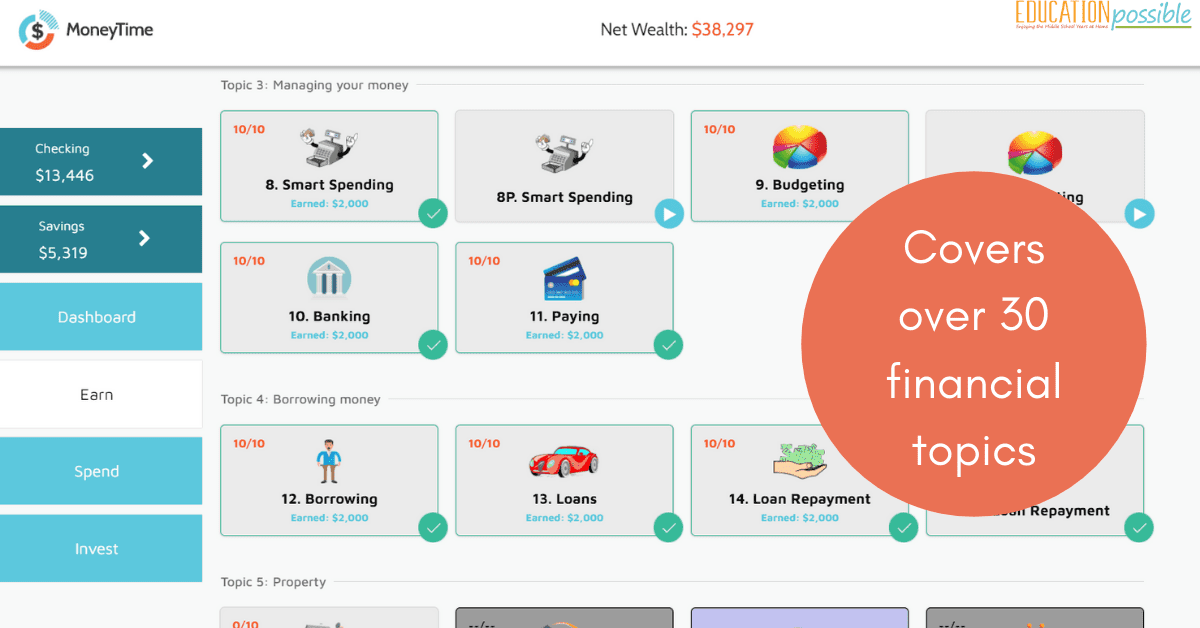Teaching Teens About Money Doesn’t Have To Be Boring
Teaching teens about money is one of the most important life skills for teens you can work on. To give them the best chance of being financially successful, they should learn how to earn, spend, and manage money before they leave home.
But where do you begin? What exactly do they need to know?
Although it may seem like a daunting task, it can actually be easy and fun to teach this subject to older kids, especially if you keep it simple and use innovative tools.
I received this product for free in exchange for writing about my experience and was also compensated for my time. I was not required to post a positive review. These are all the honest opinions of myself and my teen, who used this program. This post contains affiliate links.
Keeping it Simple When Teaching Teens About Money
Personally, I think the easiest thing you can do to teach kids about money is to make it an ongoing conversation.
In our house, instead of adding it to our homeschool curriculum as another subject, I cover topics as they arise.
For example, when it was time for my girls to open checking accounts, we discussed in-depth, things like savings versus checking, bank fees, balancing a checkbook, etc. When I gave my daughter a check to take to a haircut appointment, we reviewed how to fill one in and I had her write it out herself. We talk about investing and rates of return when they’re saving for larger purchases.
I can think of dozens of these small learning opportunities I’ve taken advantage of over the years. I want money conversations to be common in our house so the subject isn’t too overwhelming for my kids.
As you know, they don’t teach investing for kids in schools, so anything you do to share this important life skill with your homeschoolers while they’re in middle school will give them a leg up for the future.
But back to the looming question. Aside from the basics like teaching teens how to budget and why saving is important, how do you know you’re covering the right stuff to help them be financially independent?
Having Fun Teaching Financial Literacy to Teens
One of the best ways to make sure you’re covering as many topics as possible is to use a finance curriculum. However, the problem is that most of them are dry, boring, and geared toward older teens. Personally, I want to use a program that makes learning about money as fun as possible. I’ve even been known to include finance board games and other hands-on money activities into our family game time.
That’s why I was thrilled when I was introduced to MoneyTime Financial Literacy Program for homeschoolers. It’s their belief that teaching older kids about money at home can be fun for both tweens and parents.
Using MoneyTime to Teach Teens About Money
MoneyTime is an online program, geared toward tweens and teens (kids 10-14), that covers 30 different financial topics. It is simple to use and the game-like format keeps kids interested.
In each module, kids read along as avatars teach each subject. Each section takes approximately 20 minutes to complete and includes questions to answer, formulas to figure out and vocabulary words to match to definitions. At the end of each module, there’s a short quiz that will reinforce the information taught in the lesson.
It’s very interactive, so kids remain engaged.
Some of the topics covered include:
Interest
- The difference between simple and compound interest.
- Figuring out how much interest they’ll earn or pay.
- The benefit of earning interest on savings accounts.
Budgeting
- What is disposable income?
- What are wants vs. needs?
- Figuring out their income, and expenses.
Borrowing
- What are the various types of loans available?
- What is repayment and why it’s important?
- Why interest rates matter and how they affect monthly payments.
Investing
- How you can grow your wealth through investments.
- Pros and cons of various types of investments, like CDs, property, and stocks.

As I mentioned earlier, it’s easy to think that you might miss some things when teaching tweens and teens about money. This program covers such a wide variety of financial topics, you can feel confident that your kids are getting a solid base of knowledge.
One thing you can do is use this program as a jumping-off point, a way to start conversations. When you see needs, go deeper with your tween.
I would highly recommend you talk to your kids regularly as they’re working through any program to make sure you are conveying your values to them. For example, in our house, we rarely use credit cards. However, we know it’s important that our teens understand them, in order to make their own informed decisions. So when my youngest was working through the credit module, we had some good conversations about why we’ve made the choices we have.
You can use the helpful parent study guide to know what they’re learning in each module.

Teaching Older Kids How to Build Wealth
As kids move through each module, they’ll earn “money” for going through the lesson as well as for each correct answer on quizzes. This money can be used for a variety of things within the program.
Kids choose an avatar when they begin, so your tween can spend some of their money outfitting their player. They can also put some of their wages into a savings account to earn regular interest. Or they may decide to invest money in education (which will raise their salary), CDs, stocks, or property.
The goal is not only to learn about money but also to apply this knowledge to build a positive net worth.
Benefits of Using MoneyTime
In my opinion, there are quite a few benefits to using MoneyTime as a starting point in teaching older kids about finances.
- Instead of starting from scratch, the subject matter is already chosen and the curriculum is built for you.
- As your tween moves through the program, it’s simple to see the topics she understands and which ideas she’s struggling to master. This will allow you to focus your energy on the areas she needs help with instead of wasting time reviewing everything. This saves time and frustration for both you and your tween.
- Similarly, the format helps teens see which topics interest them, so it’s simple to put together a list of ideas they can dive deeper into later.
- See for yourself how a game-like format is a fun way to teach tweens about money. It engages older kids in ways that textbooks don’t, making it easier for them to learn more advanced concepts.
Whatever path you take to teach this subject, whether through a fun program like MoneyTime, covering topics as they arise with your kids, or as a formal homeschool subject, I hope you are encouraged to spend time making sure that your tweens understand the topic of money.
If you’re interested in this fun program we’ve been checking out, keep reading to see how you can get a discount on it, or possibly even get it for free!

Family subscription packages
Check out MoneyTime’s financial literacy program for homeschoolers. It offers 3 different subscription packages for families, whether you’re looking for a program for 1, 2, or 3-5 children. Contact info@moneytimekids.com for subscriptions for more than 5 children. They love working with homeschoolers and want to help where they can.



